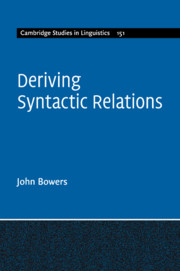Book contents
- Deriving Syntactic Relations
- Cambridge Studies in Linguistics
- Deriving Syntactic Relations
- Copyright page
- Contents
- Acknowledgments
- Introduction
- 1 Relational Derivation
- 2 Types of Lexical Projections and Arguments
- 3 Modification
- 4 Variation in Word Order
- 5 The Role of Morphology
- 6 Operators
- 7 Ellipsis
- 8 The DNA of Language
- References
- Index
- References
References
Published online by Cambridge University Press: 02 April 2018
- Deriving Syntactic Relations
- Cambridge Studies in Linguistics
- Deriving Syntactic Relations
- Copyright page
- Contents
- Acknowledgments
- Introduction
- 1 Relational Derivation
- 2 Types of Lexical Projections and Arguments
- 3 Modification
- 4 Variation in Word Order
- 5 The Role of Morphology
- 6 Operators
- 7 Ellipsis
- 8 The DNA of Language
- References
- Index
- References
Information
- Type
- Chapter
- Information
- Deriving Syntactic Relations , pp. 282 - 289Publisher: Cambridge University PressPrint publication year: 2018
